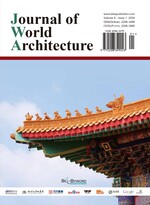Abstract
The limits of spatiality have blurred in the information age; a phenomenon that can be observed through the socio-spatial implications of Internet use in the domestic sphere. How and why are the use and organization of space-time around the Internet shaping a new domestic spatiality that intertwines the digital space with the production of social space through the practice of habits, presence, and interaction of individuals? What are the repercussions of the superimposition of digital space on human existence? The units of analysis were integrated through the sum of people and middle-class housing in the face of the digitalization process in the city of San Luis Potosi, Mexico. The questionnaire consisted of 35 questions designed from the Likert scale under the thematic order of presence, interaction, and habituality. The data were analyzed using SPSS software. This research contributes to explaining the current period in the history of inhabitable space, dominated by the simultaneous interrelationships between individuals, digital space, and architecture, which result in the detachment and devaluation of physical domestic space, while also highlighting the lack of control and regulation of individuals over the Internet.
References
Geertz C, 2015, The Interpretation of Cultures, Gedisa, Barcelona.
Silverstone R, 1989, Let Us then Return to the Murmuring of Everyday Practices: A Note on Michel de Certeau, Television and Everyday Life. Theory, Culture & Society 6: 77–94. https://doi.org/10.1177/026327689006001004
Lanier J, 2014, Against the Digital Herd, Debate, Barcelona. https://lalecturayelvuelo.files.wordpress.com/2013/08/contra-el-rebac3b1o-digital-lanier.pdf
Lefebvre H, 2013, The Production of Space, Capitán Swing, Madrid.
De Certeau M, 1988, The Practice of Everyday Life, University of California Press, Berkeley.
Han B, 2020, The Disappearance of Rituals, Herder, Barcelona. https://herdereditorial.com/la-desaparicion-de-los-rituales-9788425444005
Bauman Z, 2017, Globalization: The Human Consequences, Fondo de Cultura Económica, Mexico City.
Mcluhan M, Powers B, 2015, La Aldea Global, Gedisa, Barcelona.
Heidegger M, 1994, Build, Live, Think, Serbal, Barcelona.
Schütz A, Luckmann T, 2009, The Structures of the Life-world, Amorrortu, Buenos Aires.
Luhmann N, 2015, Communications and Body in Social Systems Theory, UNAM, Mexico City.
Lefebvre H, 1983, Presence and Absence, Contribution to the Theory of Representations, Fondo de Cultura Económica, Mexico City.
Heidegger M, 2015, Being and Time, Fondo de Cultura Económica, Mexico City.
Merleau-Ponty M, 1993, Phenomenology of Perception, Peninsula, Barcelona. https://monoskop.org/images/9/9b/MerleauPonty_Maurice_Fenomenologia_de_la_percepcion_1993.pdf
Hawkins D, 2004, Consumer Behavior: Building Marketing Strategies, Mc Graw Hill, Mexico.
Dreier O, 2008, Learning in Structures of Social Practice, in A Qualitative Stance, Essays in Honor of Steinar Kvale, Aarhus University Press, Aarhus
Przybylski AK, Weinstein N, 2012, Can You Connect with Me Now? How the Presence of Mobile Communication Technology Influences Face-to-Face Conversation Quality. Journal of Social and Personal Relationships 30: 237–246. https://doi.org/10.1177/0265407512453827
Nietzsche F, 2005, Thus Spoke Zarathustra, Prologue, Valdemar, Madrid. https://www.uma.es/nietzsche-seden/espanol/recensiones/NIETZSCHE.pdf
Norberg-Schulz C, 1975, Existence, Space and Architecture, Blume, Barcelona.
Hall E, 2003, The Hidden Dimension, Siglo XXI, Mexico. https://didacticaproyectual.files.wordpress.com/2011/10/henri-lefebvre-la-presencia-y-laausencia-1941.pdf
